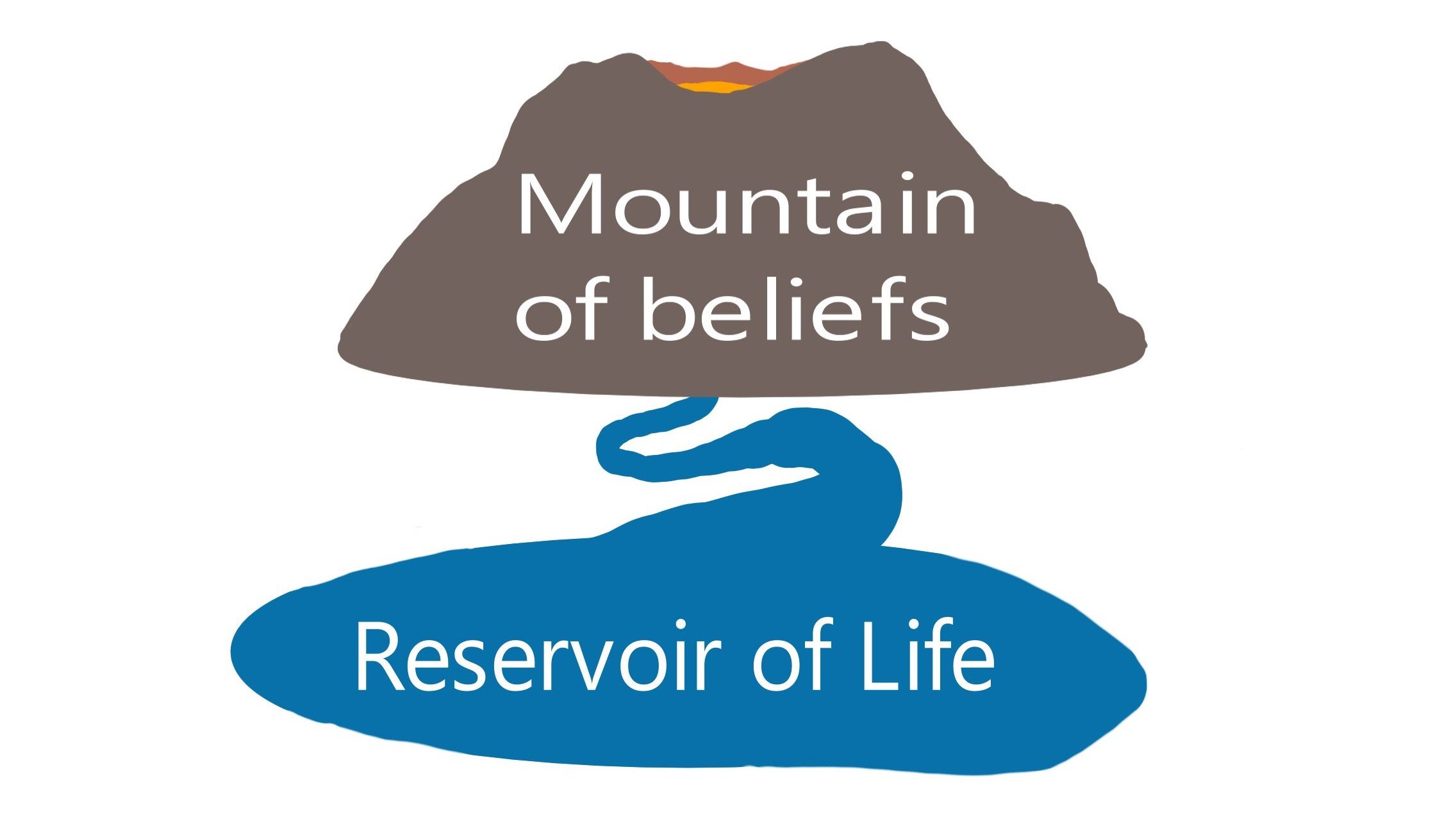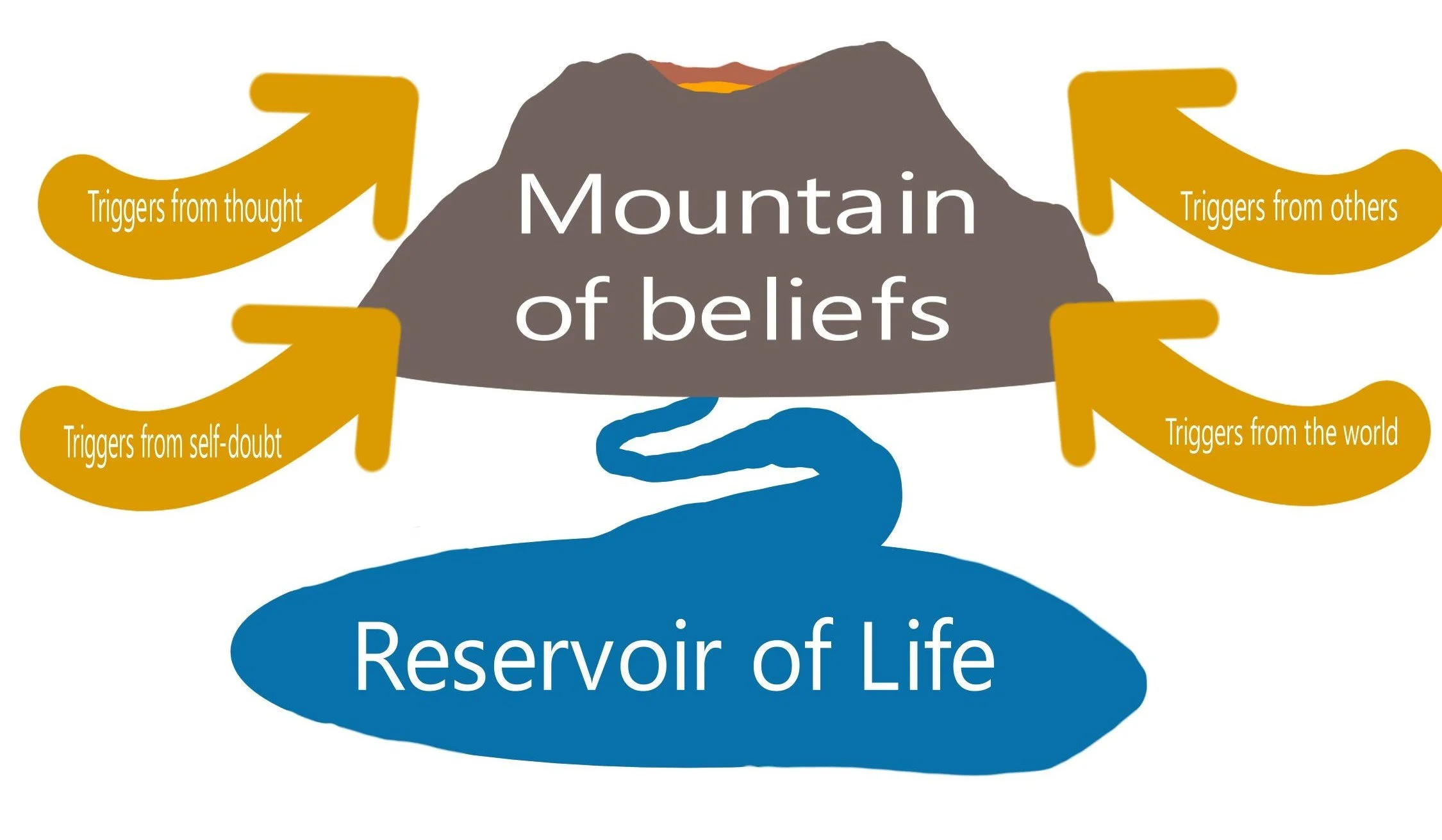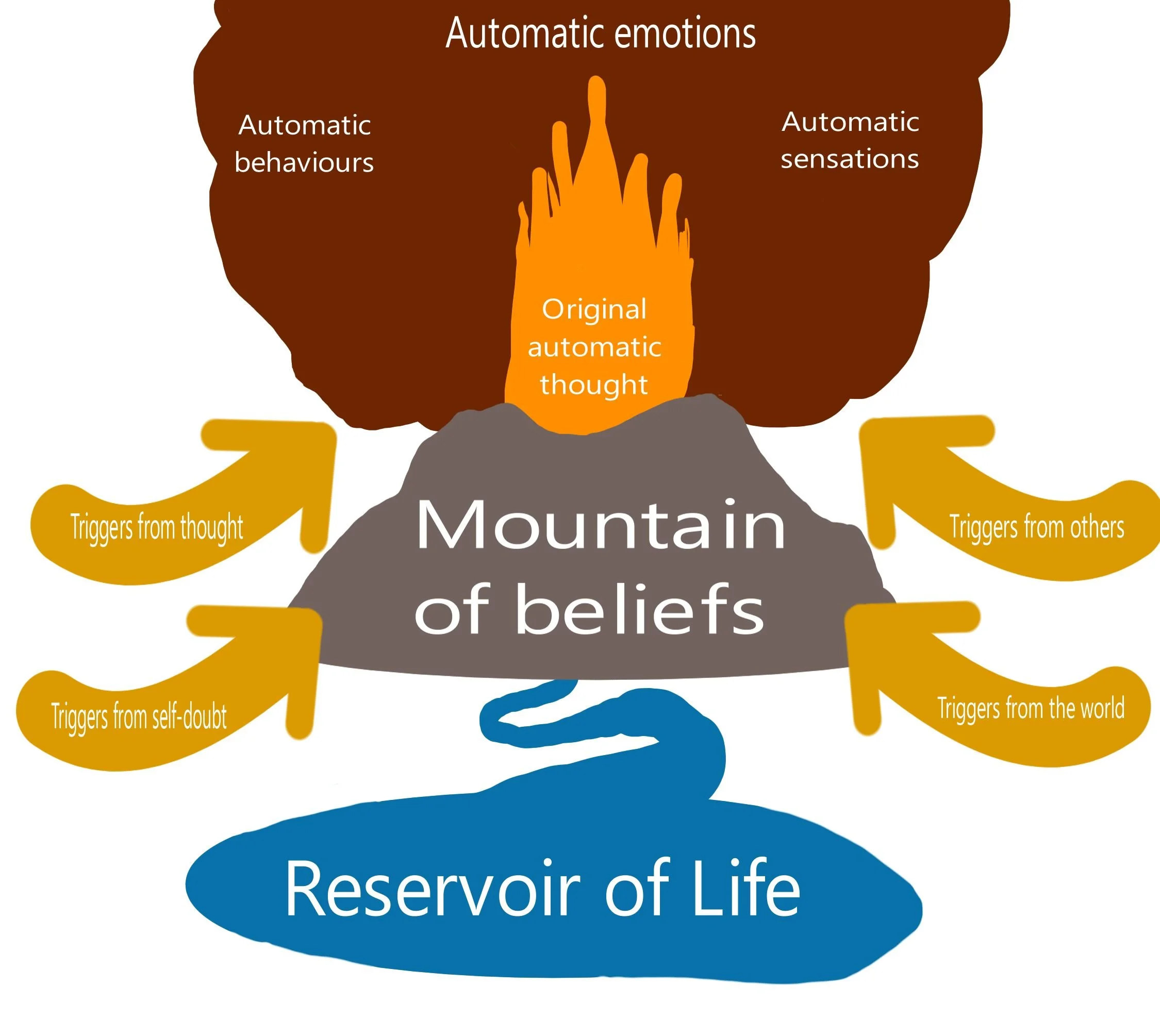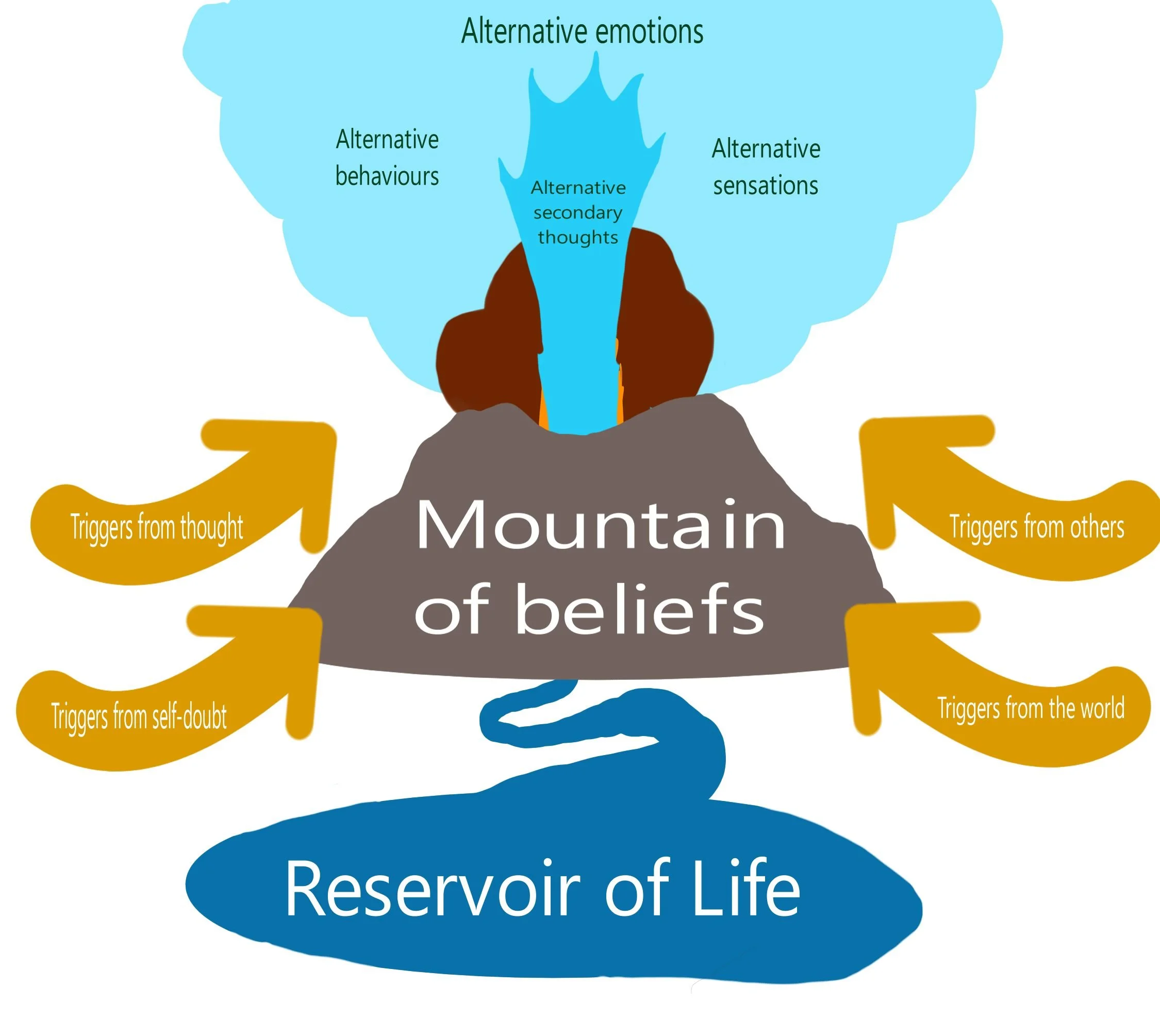My approach to coping skills for emotional pain
Photo by Photostock Editor on Unsplash
“All I know is that I just feel awful, unworthy, lost”
“I am angry. I did not deserve this”
In my work, clients often have a strong emotional sense that something is wrong in their lives. They can not explain why, and that confusion adds to their upset.
Over the years, I have developed an approach I call TEBS, i.e. Thoughts, Emotions, Behaviours, and Sensations of the body.
It is how I help clients understand why they feel upset about problem situations in their lives and develop coping skills to manage them.
I do not claim that TEBS resolves all client problems, but I believe TEBS can help clients understand their problems better and learn to live with them in a healthier way.
The Reservoir of Life
The problems in our lives don’t come out of nowhere. Just like every other story in our lives, they have a beginning.
By the time clients come to counselling, they are in the middle of it. The process of counselling is to bring them to the point where the impact of the pain from the problem is reduced.
From before we are born, our life history is formed. As life continues outside the womb, we collect experiences that contribute to who we are.
Our experience of attachments to our parental figures is very significant in creating a sense of security for us in the future.
Poor childhood attachments create problems with trusting others. This makes it difficult to build healthy relationships later in life.
In my clinical work, I refer to this as a reservoir of life that lies within us.
It is from this that our beliefs about life are formed.
The Mountain of Beliefs
Life happens.
It’s what we believe about it that determines how we react to it.
If your presumed beliefs are inherently positive, you will optimistically handle negative experiences.
You will focus on learning from the past and are more likely to have adaptive coping skills as a result.
If your presumed beliefs are inherently negative, you will let negative experiences control you. You will be emotionally stuck in depressive and anxious behaviours. Your body will be agitated and dysregulated.
Beliefs that a situation may be dangerous for us can create a broader sense of danger that is not logical.
They evoke a fear response. Fear is a primary emotion telling us that we should respond quickly to protect ourselves from a pending threat. It is a survival instinct.
Negative beliefs stemming from fear result in exaggerated, unhelpful responses such as phobias and general anxiety.
In my work, I represent our beliefs as a mountain based on our lake of personal history.
The Triggers of Life
Unfortunately, life tends to bombard us with crap. Issues such as ill health, relationship breakdown, bereavements, job loss, etc, do impact us.
How they impact us is again down to us. As I said earlier, our mindset determines the depth and type of impact experiences have on our lives.
As we age, these experiences not only add to the beliefs we have in life but also trigger pre-existing ones.
Resilience is where we develop the ability to endure negative triggers and learn to respond to them in a positive, life-strengthening way.
Emotional upset is triggered by the so-called mountain of beliefs being agitated by our circumstances of life.
We find it harder to endure a negative experience when it reminds us of hurts from our past.
The Automatic Thought
The way we first become aware of our memories being triggered is through rogue, automatic thoughts that just seem to pop into our heads. These thoughts may be deliberately brought to mind or just seep into our minds.
Rogue thoughts are expressions of our underlying beliefs about a situation. They are generally a specific reaction to a life stress trigger.
For example, you may feel insecure due to not having a strong father bond in early life. Now, in your adulthood, this is being triggered by a demanding work schedule, pushing you to take on new challenges.
The result is you think, “I can’t do this”. This may be a fleeting passing thought at first, but as the pressure mounts, this initial thought becomes bigger and more problematic, like a snowball turning into a snowman.
We simply can not ignore the power of a thought.
We are constantly having thoughts, helpful and unhelpful. One thought will result in many other thoughts. The automatic thought erupts out of our beliefs, and it seems like it can go anywhere in our life.
Automatic Emotions, Behaviours and Sensations
What do we do with all these thoughts in our heads? Where do they go?
We convert them into emotions, behaviours, and physical sensations in our bodies.
A thought about the death of a spouse may be, “I can’t live without her”. This could result in emotions of extreme sadness and being overwhelmed by grief.
Behaviours of disinterest in work, self-hygiene may occur. The body may have a sense of being completely drained, with an inability to sit still.
Our thoughts can be very persistent in wanting us to respond to them. Thoughts indicating a problem are similar to physical pain; they are a warning sign of an underlying problem that needs to be resolved.
We are aware of our psychological problems as emotions, behaviours and physical discomfort.
Clients generally think the circumstances of life are the cause of their problems.
As a result, they feel they can not stop being upset because they can not change the circumstances that they believe caused it.
This is not true. They can change how they feel.
Where is the good news?
What can be done to prevent emotional upset?
I suggest taking an objective look at the process so far described.
What can we change?
What can we not change?
Can we change the experience of our life history?
No.
So, is there any good news?
Yes.
We have the power to change our thinking and behaviour.
In my work, I ask the client to identify any situation with which they have a problem. We highlight the thoughts, emotions, behaviours and sensations of the body they experience with that situation.
I ask the client, “Which of the areas we discussed causes the problem?”
Finally, I ask, “What can they change to resolve the problem?”
A situation for a client may be that they make a mess of doing work presentations. The associated TEBS could be:
Thoughts: They are too shy to speak with confidence.
Emotions: Fear and anxiety.
Behaviour: Avoidance of all public speaking and large social situations.
Sensations: Butterflies in the tummy, and an inability to sit still.
The client will be asked which of the above causes the problem experience. Some clients will say the situation.
If situations caused problems, everyone in the same situation would have the same problem. So that is not the answer.
The answer is the thoughts.
As I have already explained, the thoughts are the source of the problematic emotional, behavioural and physical sensation responses.
Clients must develop a hope for resolving or learning to live with their problems.
With the TEBS model, this comes from developing alternative thoughts in parallel with supportive behaviours. These are the two aspects of TEBS you have control over. It will take trial and error to get this right.
The goal is to have a thought process that is able to develop an alternative positive coping mechanism, resulting in no problematic emotions, behaviours or sensations.
If the client wants to go deeper with understanding where the negative thoughts came from, they are going into the core beliefs. This is represented by the mountain of beliefs in my diagrams.
Core beliefs can be uprooted by progressive therapeutic questioning of what they are and how true they are.
Core belief change is a slow process, but once we realise that we can change them, it causes a ripple effect where the negative automatic thinking, emotions, behaviours and sensations can topple over time.
Two last points before I go
There are two important factors to changing thoughts and beliefs that I want to finish with.
First neuroplasticity. This refers to how the brain can physically change as we develop new thought patterns.
New neural pathways are developed in the brain, which help us to maintain new reactions to new thinking content and processes.
Second post-traumatic growth. This highlights that we can learn resiliency from our negative experiences in life.
Overcoming past struggles gives us the experience which we can use to overcome future similar struggles.
These two points are key to believing that change is possible. We have autonomy over our thoughts and behaviours, so we can change them.
Changing our thoughts with simultaneous support from changed behaviours can result in positive emotional and physical responses to triggering events.
This is the process I use in helping clients overcome their emotional pain.
Acknowledgement
My son, Luke Foley, provided great assistance with this blog. He did all the diagrams, without which this blog simply wouldn’t work. This took a lot of teamwork between us, and he was very patient with the process, providing high-quality images.
Further reflections on coping and emotional well-being
Anxiety is one of the places emotional pain often shows up. I explore this more in ‘Anxiety; Where fear takes over’.
The role of hope in coping is something I write about in ‘Hope’.
Coping is also about what gives us purpose; ‘What Gets You Up in the Mornings?’ looks at this in more detail.
Helpful reading
Wadhwa P.D. (2005). Psychoneuroendocrine processes in human pregnancy influence fetal development and health. Psychoneuroendocrinology 30, p724–743 https://pubmed.ncbi.nlm.nih.gov/15919579/
or try
chrome-extension://efaidnbmnnnibpcajpcglclefindmkaj/https://birthinmotion.com/wp-content/uploads/2022/02/Psychoneuroendocrine-process-in-pregnancy-and-fetal-health_wadhwa2005.pdf
Kesheshe N. (2017) Wounds From the Womb: The Impact of Trauma on the Fetal Psyche Thesis, Pacifica Graduate Institute https://www.proquest.com/openview/8971d95f7b3408bdb0125798f3f5d91c/1.pdf?pq-origsite=gscholar&cbl=18750&diss=y
McGarive S (2024) Attachment Theory, Bowlby’s Stages & Attachment Styles Positive Psychology website
https://positivepsychology.com/attachment-theory/
Fritscher L. (2024). The Psychology of Fear, verywell mind website
https://www.verywellmind.com/the-psychology-of-fear-2671696
American Psychological Association (2025) Resilience Website article
https://www.apa.org/topics/resilience
Cooks-Campbell A (2023) Triggered? Learn what emotional triggers are and how to deal with them BetterUp Website
https://www.betterup.com/blog/triggers
Vilhauer J. (2020) How Your Thinking Creates Your Reality Psychology Today website
https://www.psychologytoday.com/us/blog/living-forward/202009/how-your-thinking-creates-your-reality
Digital Learning Consultant (2018) Neuroplasticity and learning explained. YouTube
https://youtu.be/88OL8NdkV-s?si=8t_CeZZWhyIRkAWL
Collier, L. (2016, November 1). Growth after trauma: Why some are more resilient than others. Monitor on Psychology, 47(10).
https://www.apa.org/monitor/2016/11/growth-trauma
PHONE
085 857 1193
james@pct.ie
ADDRESS
123 St. John's Wood West
Commons, Clondalkin
D22 RC93
Prevail Counselling Therapy
© 2025 All Rights Reserved







